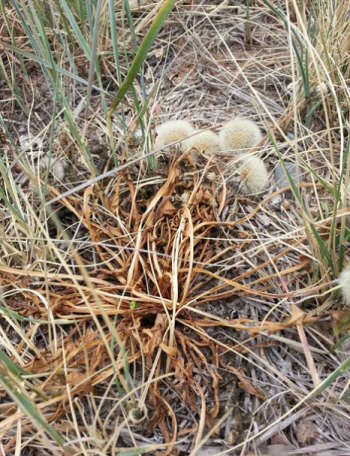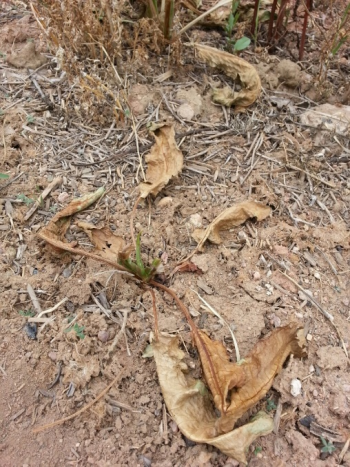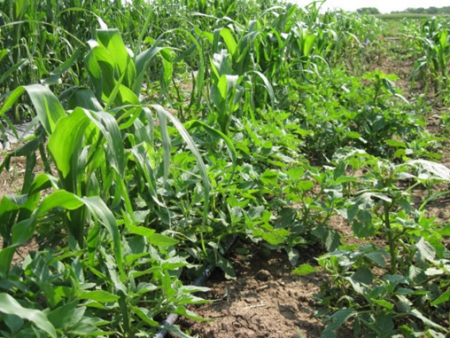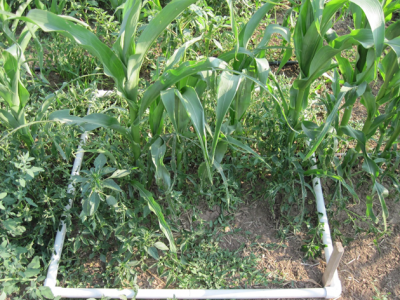eOrganic authors:
Tyler Mason, Colorado State Universtiy
Mark Uchanski, Colorado State University
Introduction
Weeds are a major concern in organic vegetable systems, as they compete with the crop for essential resources such as water, nutrients, and light. They often cause yield reductions and negative financial impacts. Left unmanaged, weeds can reduce corn yields by as much as 50% (Soltani et al., 2016). This demonstrates the importance of having an integrated weed management(IWM) plan that includes a variety of control practices. Still, not all weed management options are both affordable and effective. Organic farmers often select the preventative cultural practices, mechanical methods, and post-emergent herbicides that align with their production preferences and economic situations.

Figure 1. Caprylic/capric acid herbicide application (9% v/v) to common dandelion 1 day after treatment (DAT). Photo credit: Mark Uchanski, Colorado State University.
Examples of Weed Management Practices
Cultural practices:
- Establishing a dense crop stand and appropriate plant populations
- Planting competitive cultivars
- Rotating with suppressive cover crops
- Implementing crop rotations
Mechanical methods:
- Tilling
- Cultivating
- Hand weeding
- Abrasive weeding
- Flaming/electrical
Physical practices:
- Incorporating plastic or natural mulches as a barrier
- Using plastic covers for tarping and solarization
Post-emergent herbicides (chemical) allowed in organic systems:
- Clove oil
- Peppermint oil
- Pine oil
- Citronella oil
- Acetic acid (only nonsynthetic forms)
- Caprylic and capric acid

Figure 2. Caprylic/capric acid herbicide application (9% v/v) to curly dock 1 DAT. Photo credit: Mark Uchanski, Colorado State University.
Each weed management tool has its limitations. For example, preventative cultural practices help keep weed populations low, but may not be an option to manage weed escapes during the growing season. Mechanical cultivation is a common weed control practice, but it can also disturb the soil crust, lead to carbon emissions, increase soil erosion risk, reduce soil organic matter, and lead to an emergence of new weed seedlings (Schonbeck and Jerkins, 2019). In addition, labor for hand weeding is expensive and not always readily available. A final example, acetic acid, (AA) 20% carries a “danger” signal word on the label. It is also expensive and only somewhat effective on young annual broadleaf weeds, <4” in height.
Some producers may wish to make a post-emergent herbicide application, but the nonsynthetic form of AA has been one of few options for many years. Because it is only somewhat effective on young, small weeds (Evans and Bellinder, 2009), AA is only helpful for a very short time frame. In addition, AA is costly ($2,200/ac) to use at its most effective spray volume of 100 gal/ac, 20% v/v, undiluted (Weber and Shrefler, 2006). Our objective was to compare weed-control efficacy and cost of a promising new post-emergent herbicide—a mixture of caprylic and capric acids (CA)—to AA in sweet corn under organic management.
Caprylic and Capric Acid Background and Uses
Caprylic acid is a plant extract derived from coconut oil and palm seed kernel (Penner et al., 2011). A mixture of caprylic acid (47% v/v) and capric acid (32% v/v) functions as a contact, post-emergent nonselective herbicide (Figs. 1 & 2). The desiccant mode-of-action burns down annual and perennial weed species. It is sold under the trade name Suppress® Herbicide EC. HomePlate® is another post-emergent herbicide derived from caprylic and capric acids at 44% and 36% v/v, respectively. Both are approved for use in organic systems, and are “allowed with restrictions” for use in and around all food crops.
“Allowed with restrictions” indicates that Suppress® Herbicide EC “may only be used if the requirements of USDA NOP 205.206(e) are met, which requires the use of preventive, mechanical, physical, and other weed management practices." (OMRI, 2019). In addition, Suppress® would need to be on the approved materials list by a certifier and included as part of the organic system plan. For example, a grower could plant a cover crop, incorporate crop rotations, till, transplant into black plastic mulch, and mechanically cultivate with a rotary hoe. The grower would document these actions before applying CA.
CA has the ability to control mature weeds ≤9” in height when applied between furrows in a strawberry crop (Daugovish et al., 2015). CA also controlled woolly distaff thistle as much as 88% on rangeland (DiTomaso et al., 2017). In a greenhouse study (April 2017) we observed that CA applied at the 3-leaf collar stage (V3) or younger lead to sweet corn lodging and death. However, the crop could withstand the chemical injury when CA was applied ≥ V4. There is a need for CA research in vegetable crops.
Materials and Methods
Treatments and Experimental Design
In 2017 and 2018, we evaluated CA under field conditions at the V4/V5 stage (June-August) in an organic sweet corn system at the Agriculture Research Development and Education Center, South in Fort Collins, CO (5,003’ elevation). After the soil was rototilled, ‘Nirvana’ sweet corn seeds were sown—this cultivar was a top performer for yield and flavor based on previous cultivar trials. The research plots were under moderate weed pressure from Palmer amaranth, field bindweed, common purslane, Eastern black nightshade, prickly lettuce, common lambsquarters, Venice mallow, and green foxtail (Fig. 3).

Figure 3. Untreated control sweet corn weed management plot 1 Aug. Photo credit: Tyler Mason, Colorado State University.
The field study was set up as a randomized complete block design with three replications and five weeding treatments. The individual plots were 7.5’ x 10’ with a 3’ buffer on both sides. The five treatments and their respective application timings are listed in Table 1. The application volume was 210 gal/ac, or approximately 5 gal/1,000 ft2. All appropriate treatment applications were made on 31 July. A Solo backpack sprayer (Solo model #475) with a flat spray jet nozzle (TeeJet 8005-VP) and a walking speed of approximately 2.2 mph was used. In addition, the nozzle was held at a 45° angle to the crop and approximately 8” away; it was positioned 10” off the ground to simulate a shielded spray. The hand-weeded treatments were done with a stirrup hoe.
Table 1. Weeding Treatments in an organic sweet corn system
| Treatment | Method | Concentration | Application Volume | Timing |
|---|---|---|---|---|
| Untreated | N/A | N/A | N/A | Not weeded |
| Hand weeded | Stirrup hoe | N/A | N/A | Weekly |
| Hand weeded (once at V4/V5) | Stirrup hoe | N/A | N/A | At V4/V5 |
| Acetic acid | Backpack sprayer | 20% v/v solution (undiluted) | 5 gal/1,000 ft2. | At V4/V5 |
| Caprylic/capric acid | Backpack sprayer | 9% v/v solution | 5 gal/1,000 ft2. | At V/V5 |
Data Collection and Timeline
Sweet corn seeds were sown on 22 June 2018 with rows on 30-inch centers and 6 inches between plants in-row. Square quadrats (1m x 1m) were established at crop emergence and monitored throughout the season to track percent weed control over time (Fig. 4). Weeding treatments were ended on 31 July. The crop was harvested by hand between 14 and 24 September. Data was collected on percent crop damage from herbicide contact, marketable yield, average ear weight, kernel soluble sugars, and fresh-eating quality (flavor and tenderness).

Figure 4. One meter squared survey quadrat. Photo credit: Tyler Mason, Colorado State University.
Economic Analysis
The time it took to hand weed a 180 ft2 plot with a stirrup hoe was recorded for all treatments except the untreated (weedy control). The time (28.25 minutes) it took to hand weed was extrapolated to 1,000 ft2. Labor costs were estimated at $12 per hour, which brought the cost of the first hand-weeding event to $31 per 1,000 ft2. The time it took to hand weed the weed-free check (24.75 minutes) was recorded. This brought the cost per maintenance-weeding event to $28 per 1,000 ft2. The AA material cost was calculated based on $22 per gallon; CA was based on $72 per gallon. Both AA and CA applications included 1.5 hours for labor ($18). These season-long costs were based on information available in 2019.
Fresh Eating Quality
A sensory evaluation for flavor and tenderness was conducted using parameters from the Northern Organic Vegetable Improvement Collaborative (NOVIC) protocols (Silva and Bruce, 2016). The scale for flavor and tenderness ranged from 1-5, with 1 representing ‘objectionable’ and 5 representing ‘excellent, sweet and good corn flavor.’
Statistical Analysis
Differences between treatment means for percent broadleaf weed control, marketable yield, average ear weight, kernel soluble sugars (°Brix), flavor, and tenderness were analyzed using an analysis of variance (ANOVA) statistical approach in R statistical software, α=0.05, with a Tukey adjustment for multiple comparisons.
Results
Control of broadleaf weed species such as field bindweed, Palmer amaranth, and eastern black nightshade was limited to 41% for AA (Table 2 and Fig. 5). This was significantly lower broadleaf control compared to CA at 86% (Table 2 and Fig. 6). Fourteen DAT, CA demonstrated significantly higher control than AA on broadleaf weeds at 65 and 26 percent, respectively. There were no significant differences in broadleaf control between the hand-weeded at V4/V5 treatment, the CA treatment, and the hand-weeded weekly treatment at 1 and 14 DAT. The level of green foxtail control was generally lower, although formal statistical comparisons were not possible.
Applying a post-emergent herbicide did not reduce the number of sweet corn ears produced (Table 2). However, the plots treated with CA had an average ear weight (0.49 pound/ear) that was significantly higher than the untreated check (0.39 pound/ear). In addition, an herbicide application of CA or AA did not affect the sweet corn flavor, tenderness, or kernel soluble sugar content (data not shown).
The economic analysis demonstrated that CA ($52/1,000 ft2) is about half the cost of AA ($128/1,000 ft2), while providing superior weed control. A single hand weeding at V4/V5 costs $59/1,000 ft2 and weekly hand weeding through the season costs $279/1,000 ft2. The five weeding treatments: untreated weedy check, acetic acid, hand-weeded at V4/V5, caprylic/capric acid, and hand-weeded (weed-free control) achieved 0, 41, 89, 86, and 100 percent broadleaf weed control 1 DAT, respectively.
Table 2. A comparison of weeding treatments and percent broadleaf weed control, associated season costs, and yield parameters in an organic sweet corn system based on 1,000 square feet1.
| Treatment | Percent Control (DAT) | Associated Costs (Season)6 | Marketable Yield (Dozen) | Ear Weight (Pounds) | ||
|---|---|---|---|---|---|---|
| Untreated (weedy control) | 0 a | 0 a | 0 a | $0 | 62 | 0.39 a |
| Acetic acid 5 gal/1,000 sq. ft.2 | 41 b | 26 a | 11 a | $128 | 59 | 0.47 ab |
| Hand weeded (once at V4-V5) | 89 c | 33 ab | 16 ab | $59 | 66 | 0.45 ab |
| Caprylic/capric acid 5 gal/1,000 sq. ft.4 | 86 c | 65 b | 34 b | $52 | 63 | 0.49 b |
| Hand weeded (weed-free control)5 | 100 c | 66 b | 100 c | $279 | 69 | 0.45 ab |
2Acetic acid treatment involved one mechanical cultivation then one herbicide application at the 4-leaf collar/5-leaf collar (V4/V5) stage from 6-22-18 to 8-31-18.
3Hand-weeded (weed-free check) treatment involved weekly cultivation events with a stirrup hoe for 10 weeks from 6-22-18 to 8-31-18.
4Caprylic/capric acid treatment involved one mechanical cultivation then one herbicide application at V4/V5 from 6-22-18 to 8-31-18.
5Hand-weeded (once at V4/V5) treatment involved two mechanical cultivation events with a stirrup hoe from 6-22-18 to 8-31-18.
6Labor costs estimated at $12/hour; material costs based 2019 prices per 1,000 feet2.
Discussion
Our observations of AA and CA are similar to what has been reported in the literature. Rhoads (2007) reports that acetic acid stunts weeds more often than not, but regrowth would occur after a few days then continue growing vigorously. On the other hand, Daugovish and colleagues (2015) observed nearly 90% control of broadleaf weeds after an application of CA (12 fl oz/100 gal) to weeds in organic strawberry furrows. Occasionally, surviving weeds from a CA application started to regrow. We observed the same for perennial broadleaf weeds.
An Organic System Plan (OSP) outlines the steps farmers plan to take and the inputs they may decide to use when they encounter production issues. Taking an IWM approach is a practical way to address weedy issues because it employs multiple strategies. It is important to note that managing weeds during the critical period for each vegetable crop helps reduce the impact of weeds on yield. In sweet corn, this is between V4 and V8 (Williams, 2006). Many farmers include mechanical cultivation and cultural practices such as planting cover crops, implementing crop rotations and incorporating plastic or organic mulches into their OSP. When these practices are used before weeds set seed, they help to reduce the weed seed bank over time, which is also key to a successful IWM program.
Acetic acid (20%) and a mixture of caprylic and capric acids are two post-emergent herbicides, among others, that are “allowed with restrictions” for organic agricultural food crops such as vegetables, tree fruits, sweet corn and strawberries. CA provides significantly better control of annual and perennial broadleaf weed species compared to AA with 65% and 26% at 14 DAT, respectively. This study indicates broadleaf weed species such as Palmer amaranth, field bindweed, common purslane, eastern black nightshade, prickly lettuce, common lambsquarters, and Venice mallow can be controlled with a CA application without negative impact to sweet corn yield. CA provides less control (20%) of grassy weed species such as green foxtail. However, no adjuvants were used in this study. Evaluating the addition of an adjuvant, lower application volumes (gal/ac), and lower herbicide application rates are the next research objectives.
Recommendations and Conclusions
Be sure to wait to spray sweet corn until the V4/V5 stage to prevent crop lodging and death. The economic analysis demonstrated that CA ($52/1,000 ft2) is about half the cost of AA ($128/1,000 ft2) when used as an input for weed control in an organic system. Caprylic/capric acid may be an input worth including in an OSP for organic vegetable growers and other high-value specialty crop producers wanting to use an effective post-emergent herbicide.
IMPORTANT: Before using any pest control product in your organic farming system:
- Read the label to be sure that the product is labeled for the crop and pest you intend to control. Make sure it is labeled to use in the state, county, or other location where it will be applied.
- Read and understand all safety precautions and application restrictions.
- Make sure that the brand name product is listed in your Organic System Plan and approved by your USDA-approved certifier. If you encounter an unanticipated pest problem, get approval from your certifier before using a product that is not listed in your OSOP—doing otherwise may put your certification at risk.
- Wear proper personal protective equipment (PPE) and observe the restricted entry interval (REI)
References and Citations
- Birthisel, S. K., E. R. Gallandt, and A. E. Souza Cunha. 2018. Solarization and tarping for weed management on organic vegetable farms in the Northeast USA [Online]. eXtension Foundation, eOrganic Community of Practice. (Available online at https://eorganic.org/node/25440 (verified 26 Apr 2023).
- Daugovish, O., J. Muramoto, and R. Smith. 2015. Organic pest management options: Anaerobic soil disinfestation (ASD) and weed control with new organic herbicide. CAPCA Adviser 44-46.
- DiTomaso, J. M., G. B. Kyers, D. J. Lewis, and J. A. Roncoroni. 2017. Conventional and organic options for the control of woolly distaff thistle (Carthamus lanatus). Invasive Plant Science Management 10: 72—79. (Available online at https://doi.org/10.1017/inp.2016.4) (verified 26 Apr 2023).
- Evans, G. J. and R. R. Bellinder. 2009. The potential use of vinegar and a clove oil herbicide for weed control in sweet corn, potato, and onion. Weed Technology 23: 120—128. (Available online at: https://www.jstor.org/stable/40587050?seq=1#page_scan_tab_contents (verified 26 Apr 2023).
- Leslie, A., G. Chen, and C. R. Hooks. 2016. Organic integrated weed management in vegetables [Online]. eXtension Foundation, eOrganic Community of Practice. Available at: https://eorganic.org/node/19339 (verified 26 Apr 2023).
- Northern Organic Vegetable Improvement Collaborative (NOVIC). About NOVIC and our collaborators. eOrganic. Available online at: http://eorganic.info/novic/about (verified 26 Apr 2023).
- Organic Materials Review Institute. Suppress® Herbicide EC. Available online at: https://www.omri.org/ubersearch/results/suppress (verified 26 Apr 2023).
- Organic Variety Trial Reports. 2013. eOrganic. Available online at: https://varietytrials.eorganic.info/ (verified 26 Apr 2023).
- Penner, D., R. Coleman, and J. Michael. 2011. Novel formulations on an organic acid herbicide. Journal of ASTM International 8(5): 1-5. PDF available for purchase at: https://doi.org/10.1520/JAI103400 (verified 26 Apr 2023).
- Rhoads, D. 2007. Development of organic weed control strategies. National SARE Database: final report FNC05-582. Available online at: https://projects.sare.org/project-reports/fnc05-582/ (verified 26 Apr 2023).
- Schonbeck, M., and D. Jerkins. 21 Feb. 2019. Soil health and organic farming webinar series [Online]. eXtension Foundation, eOrganic Community of Practice. Available at: https://eorganic.org/node/25148 (verified 26 Apr 2023).
- Silva, E., and D. Bruce. 2016. Variety trial report: 2016 NOVIC sweet corn report [Online]. UW-Madison Organic Research and Extension program. Available at: https://varietytrials.eorganic.info/node/736 (verified 26 Apr 2023).
- Soltani, N. J., J. A. Dille, I. C. Burke, W. J. Everman, M. J. VanGeseel, V. M. Davis, and P. H. Sikkema. 2016. Potential corn yield losses from weeds in North America. Weed Technology 30: 979-984. Available online at: https://doi.org/10.1614/WT-D-16-00046.1 (verified 26 Apr 2023).
- Webber III, C. L., and J. W. Shrefler. 2006. Vinegar as a burn-down herbicide: Acetic acid concentrations, application volumes, and adjuvants. Vegetable Weed Control Studies, Oklahoma State University, Division of Agricultural Sciences and Natural Resources, Department of Horticulture and Landscape Architecture. Stillwater, OK. MP-162, p. 29—30.
- Wortman, S., F. Forcella, S. Clay and D. Humburg. 2018. Abrasive weeding: A new tool for weed management in organic agriculture [Online]. eXtension Foundation, eOrganic Community of Practice. Available at: https://eorganic.org/node/23223 (verified 26 Apr 2023).
- Williams, M. II. 2006. Planting date influences critical period of weed control in sweet corn. Weed Science 54: 928—933. Available online at: https://www.jstor.org/stable/4539485 (verified 26 Apr 2023).



